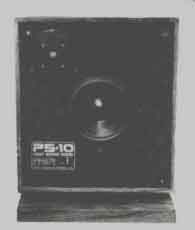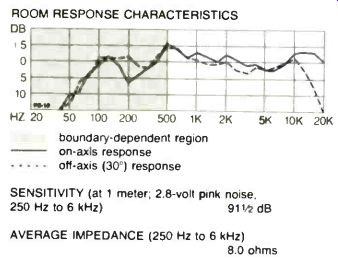
Design Acoustics' Small Speaker with a Big Voice
Design Acoustics PS-10 loudspeaker, in wood cabinet with walnut-grain vinyl finish.
Dimensions: 11 by 14 inches (front), 14 inches deep.
Price: $250.00 EACH ($500.00 pair)
Warranty: Limited, five years parts and labor.
Manufacturer: Design Acoustics Corp., 1225 Commerce Drive. Stow, Ohio 44224.

ROOM RESPONSE CHARACTERISTICS
DESIGN ACOUSTICS HAS NEVER settled for the ordinary in loudspeakers. The company's first effort was dodecahedral in shape, with its twelve sides approximating a pulsating sphere. A later design, the Model LDM (test report, June 1980), was in most respects a conventional two-way mini-speaker, but for its beveled front edges designed for minimum diffraction. Al though still committed to the goal of low diffraction, Design Acoustics is now offering a bookshelf speaker intended to provide what other small speakers frequently can not-ample low-frequency output. To that end, the PS-10 resembles no other book shelf speaker we know of, other than the company's own smaller PS-8.
Though it probably won't fit comfortably on most shelves, its 14-inch depth is no accident: To make sure that reflections from shelf walls, books, and so forth won't degrade performance, the speaker's baffle is intended to protrude a bit when the system is seated on a typical 12-inch-deep shelf. For those who object to this on aesthetic grounds, the company has an optional wooden stand that raises the PS-10 some two feet off the floor.
Another notable difference from more standard speakers of this type is the use of an integral base. No mere cosmetic conceit, the raised bottom of the enclosure permits the mounting of a 10-inch down-firing woofer. This was the only way to include such a large driver and still keep overall system height to acceptable shelf limits; moreover, the designers say that the small front baffle helps to minimize diffraction.
Other design features include an interesting crossover arrangement that lets the midrange driver act more as a mid-woofer, covering the range from 200 Hz to 2 kHz.
The reason, according to Design Acoustics, is to eliminate the possibility of crossover-induced anomalies in the critical midrange.
Shipped in mirror-image pairs, each PS-10 has a tweeter-level control. Amplifier connections are made via spring-loaded clips that accept banana plugs or stripped wire.
The PS-10 proved itself a worthy per former in Diversified Science Labs' tests.
Power handling is exceptional. Indeed, in the 300-Hz pulse test the speaker accepted the full output of DSL's test amp--57 1/2 volts peak (equivalent to 26 1/4 dBW, or 413 watts, into 8 ohms). The resulting sound pressure level is a staggering 117-1/4 dB.
Sensitivity is also quite high, with the PS-10 producing a sound pressure level of 91 1/2 dB with a 2.8-volt input (equivalent to 0 dBW, or 1 watt, into 8 ohms).
Distortion measurements likewise connote good design. At a moderate 85-dB sound pressure level, total harmonic distortion (THD) remains less than 1% from 100 Hz to 10 kHz, and at 90 dB SPL, THD increases only slightly, barely exceeding 1% from 100 Hz to 10 kHz. Impedance, too, appears well controlled. From a mini mum of 4.7 ohms at 120 Hz, it rises to a maximum of 12.8 ohms at 210 Hz and remains at or above 6.4 ohms across the midrange and into the treble. Impedance does vary slightly in the treble according to the setting of the tweeter-level control, but not to any significant degree. The control itself is very gentle in its action, matching almost exactly the ±3 dB range marked on its continuously adjustable rotary knob. Its action begins to be felt at 2 kHz and reaches its maximum at 20 kHz.
Placed according to the manufacturer's recommendation, well away from the back wall and two feet off the floor, the PS-10 exhibits some response irregularities, although our listening tests (conducted under similar conditions) disclosed little evidence of the drop in output at 200 Hz shown by the on-axis curve. Response is reasonably smooth through the midrange and treble, with the latter showing just the usual amount of off-axis drop-off as directivity increases at very high frequencies.
Our experience does suggest that best performance will indeed be obtained with the PS-10's mounted out into the room, away from walls. Placed against the rear wall, they sound a little bass-heavy (seemingly confirming the response bump at 126 Hz in the curves DSL made with the speaker in that position). With the speakers optimally set up, the overall sound is smooth, clean, and detailed. Bass is surprisingly well maintained for so small a speaker.
Imaging is also outstanding, with firm, stable stereo localization and a good sense of spaciousness and depth.
The PS-10 is not an easy speaker to characterize, but then innovative products often resist pigeonholing. The consensus here is that Design Acoustics has succeeded in building a loudspeaker that will produce wide-range, neutral sound, provided you take some care in finding the optimum placement for it. The PS-10's sonic performance belies its size and price to a very great degree, and we would unhesitatingly advise that you add it to your auditioning list.
------
(High Fidelity, Jan. 1983)
Also see:
Polk SDA-1 Stereo Dimensional Array speaker (Equip. Report, Jan 1983)
Technics SU-V9 Integrated amplifier (Equip. Report, Jan 1983)
Sherwood S-6020CP preamplifier (Equip. Report, Jan 1983)
Dynavector DV-23R moving-coil phono cartridge (Equip. Report, Jan 1983)